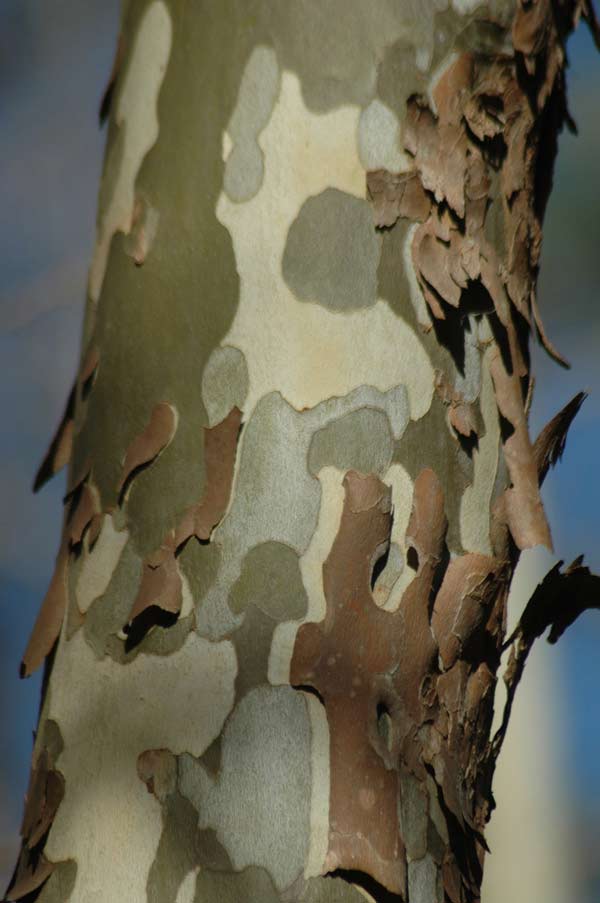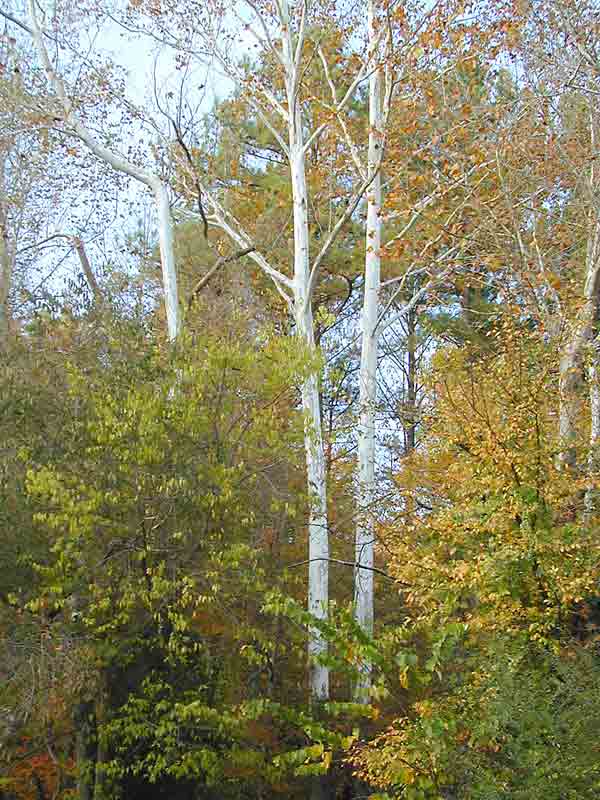In praise of the mighty sycamore

Sycamore bark peels off to change the coarser grey-brown-green bark of the lower trunk to a smooth stark white trunk above. Photo by Peter White.
By Ken Moore
Flora Columnist
Botanical Garden director Peter White loves trees. Chatting with him over a coffee at Open Eye, I mentioned featuring the Sycamore (Platanus occidentalis) in The Citizen’s “Flora†column. He enthusiastically responded with numerous stories.
Its beauty is somewhat obscured by the foliage during the growing season, but in the winter no tree in the Carolinas is like the sycamore with its distinctive bark and habit. The base is somewhat like a typical tree bark. Now, I’ll leave it to your imagination to visualize a “typical†bark. As your eye travels up the trunk of the tree, you will notice bark peeling off in large irregular scales colored from gray and tan to green. Further upwards, the trunk becomes very smooth and snow white in color, reaching skyward to the very branch tips. During the winter months, even viewed from speeding vehicles, the stark white stems along riverbanks are unmistakable. It occurs throughout our state – one of our most magnificent native trees.
Single trunk specimens are most commonly seen in urban landscapes. Many of the specimens found in the wild are multi-trunked. Next time you are walking along a stream or river, take time to notice how many of the trees are multi-trunked with two of more stems. Flooding and logging in floodplains cause injuries to trees and loss of main stems. The trees rebound vigorously with “stump sprouts†that mature into dramatic multi-trunk specimens.
Asked for an explanation for the unusual smooth white upper bark, White can describe a number of interesting theories. One is that the white bark evolved to make a surface against which caterpillars were easily picked off as tasty morsels by birds, a clever sycamore adaptation to protect its leaves. Another theory is that some vines tend to grow toward the dark. This sounds logical since many tree trunks are rough and dark and provide helpful vertical avenues for climbing toward necessary sunlight.
The brilliant white upper trunks of the sycamore discourage the advance of such vines that would compete for the available sunlight. Other theories abound.
In the presence of a sycamore, I like to reflect on the rich heritage of these trees as described by our pioneering forbears. Descriptions of specimens of unbelievable proportions depict trees that, though hollow inside, were vigorous, a characteristic of the sycamore. In the 1700s, when the Morgan family arrived to establish their homestead along Morgan Creek (present-day Finley Golf Course and Mason Farm Biological Reserve), they set up a household inside an old sycamore tree while they worked for months to build a proper farmhouse. There are descriptions of trees large enough to provide temporary shelter for a dozen soldiers on horseback.
Other sycamore stories describe the wildlife value and the use of the hard center cores of the sycamore ball seed heads as buttons on Native American and pioneer clothing, and on and on …
I suspect some of you also have stories, and I hope you share my feeling for sycamore as a favorite tree, such that when I see one it’s like seeing a good friend whose mere presence brings cheer.
Email Ken Moore at flora@carrborocitizen.com. Find previous Ken Moore Citizen columns at The Annotated Flora (carrborocitizen.com/flora).



Comments are closed.